Easy Pavlova with Fruit Medley
Crisp on the outside, marshmallowy on the inside, and topped with billowy whipped cream and a vibrant fruit medley, this pavlova is sure to steal the show at any gathering. Plus, it’s simpler to make than you might think!
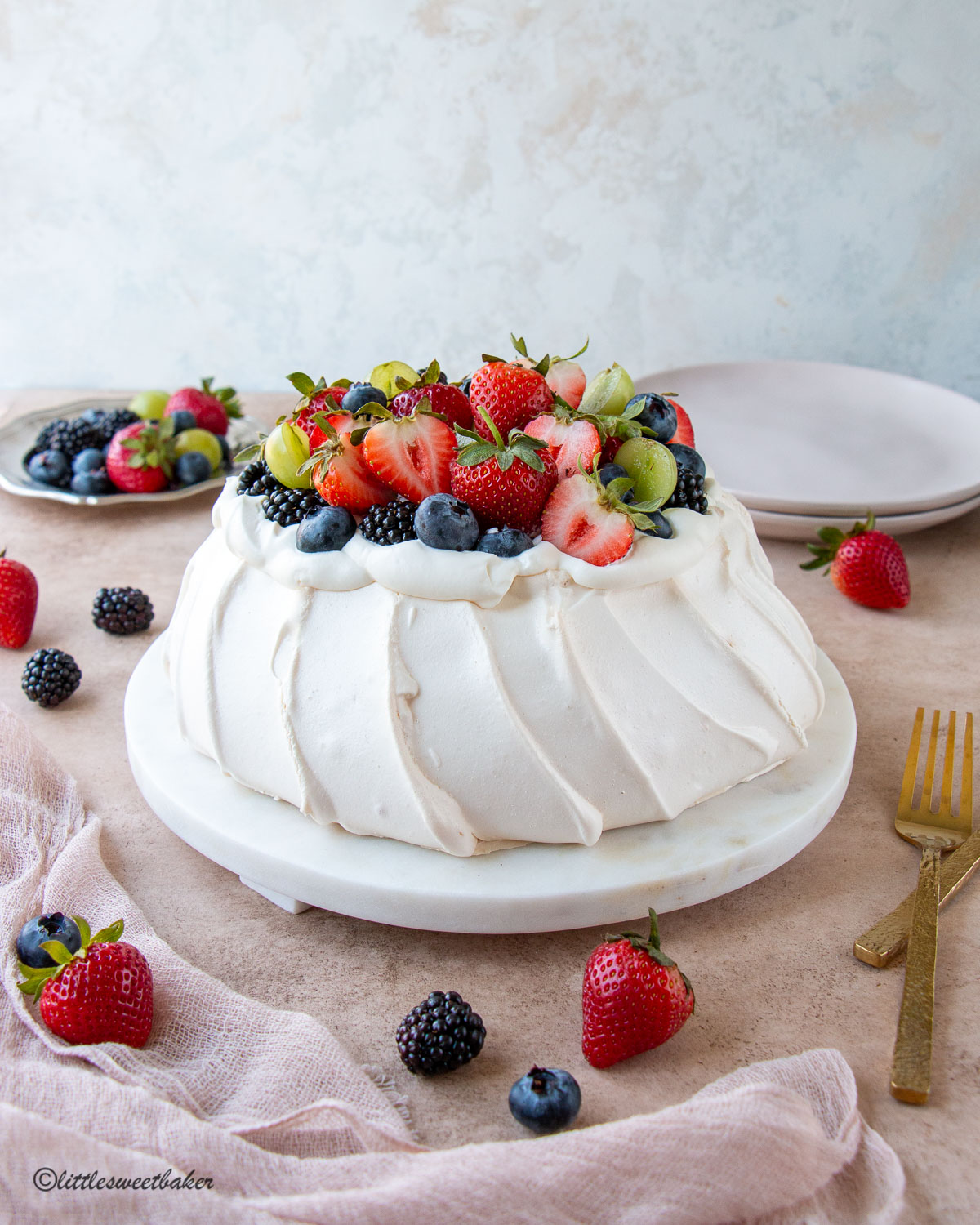
What is pavlova?
Pavlova is a popular dessert that originated in either Australia or New Zealand (both countries claim its invention) and is named after the Russian ballerina Anna Pavlova. It consists of a crisp meringue base that is typically topped with whipped cream and fresh fruit.
The meringue base of pavlova is made from stiffly beaten egg whites and sugar, which are baked at a low temperature until crisp on the outside but soft and marshmallow-like on the inside. This results in a dessert that is light, airy, and irresistibly delicious.
Why you’ll love this recipe:
- Easy streamlined method – Pavlova can be very technical, but it can be made easy. In this recipe, I’ll highlight the key factors for success without overcomplicating it.
- Perfect texture – The contrast between the crispy outer shell and cloud-like, melt-in-your-mouth center makes every bite feel like heaven.
- Exquisite taste – The pavlova itself tastes like a lightly toasted, fluffy marshmallow. The whipped cream adds a rich and creamy flavor and the fresh fruit adds a bit of tartness and vibrance to balance all the components
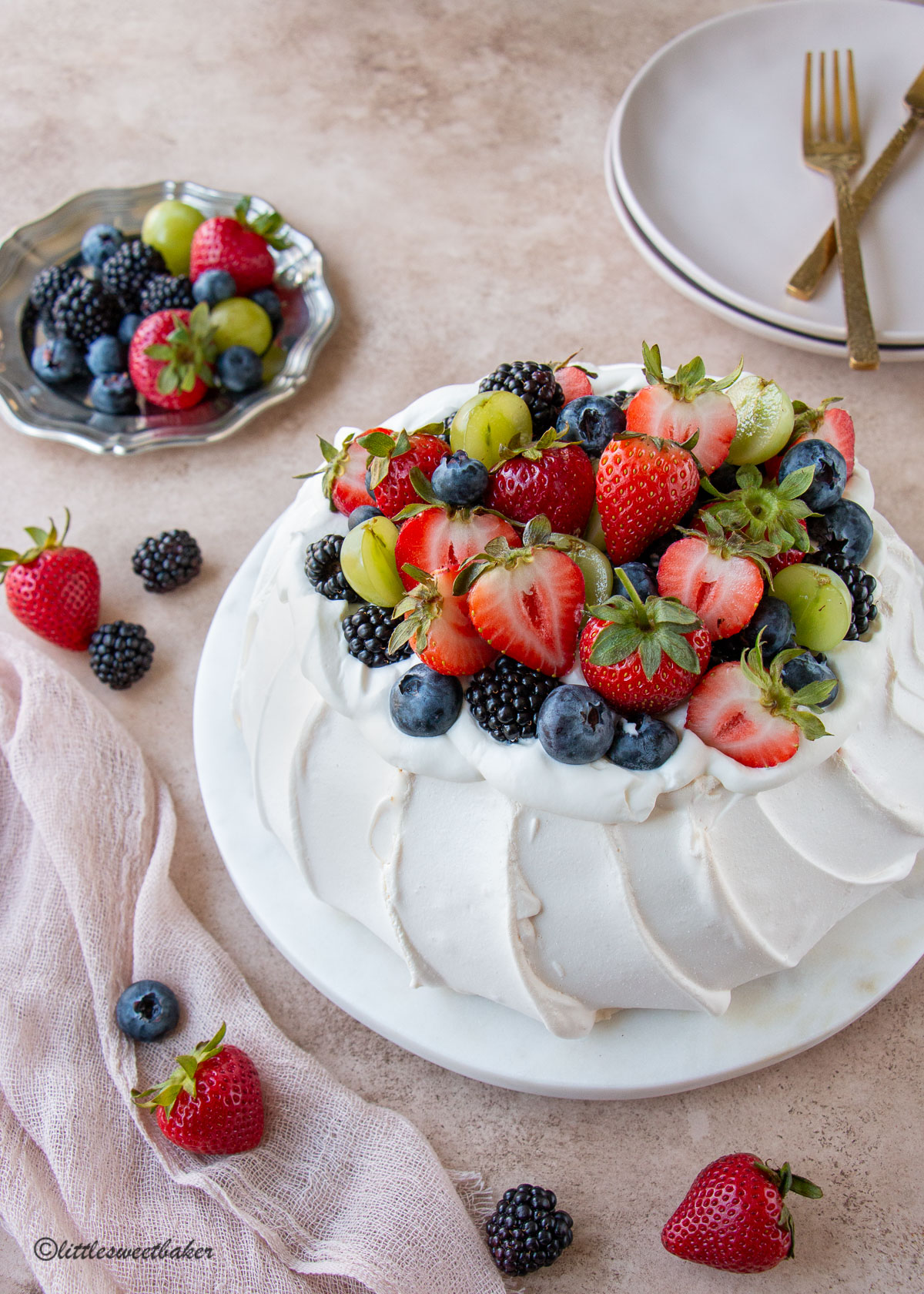
Ingredients you’ll need for the pavlova:
- Egg whites – The egg whites serve as the foundation of the pavlova, providing structure and stability to the meringue. When whipped, the proteins in the egg whites trap air, creating a light and airy texture.
- Sugar (preferably superfine or caster) – Sugar not only adds sweetness to the pavlova but also plays a critical role in stabilizing the whipped egg whites. As sugar is gradually incorporated into the egg whites, it dissolves, creating a glossy meringue with a smooth texture.
- Cornstarch – Cornstarch acts as a stabilizer in the pavlova, helping to absorb excess moisture to prevent the meringue from “weeping”.
- White vinegar – White vinegar serves as an acid in the pavlova recipe, which helps to strengthen the protein structure of the egg whites and stabilize the meringue.
- Vanilla extract – Vanilla extract enhances the flavor of the pavlova, imparting a warm and aromatic note to the meringue.
- Heavy or whipping cream – When whipped, this transforms into a luxurious and airy topping for the pavlova. Its rich and creamy texture contrasts beautifully with the lightness of the pavlova. It also serves as a decadent cushion for the fruit.
- Powdered sugar – Used to sweeten the whipped cream. It also helps stabilize it because powdered sugar contains cornstarch, helping the whipped cream hold its shape for longer periods.
- Assorted fruits: The assortment of fresh fruits adds color, freshness, and texture to the pavlova. Additionally, the acidity from the fruit helps to balance the sweetness and richness of the meringue and whipped cream.
How to make a pavlova:
(The ingredient amounts are listed in the printable recipe card further below.)
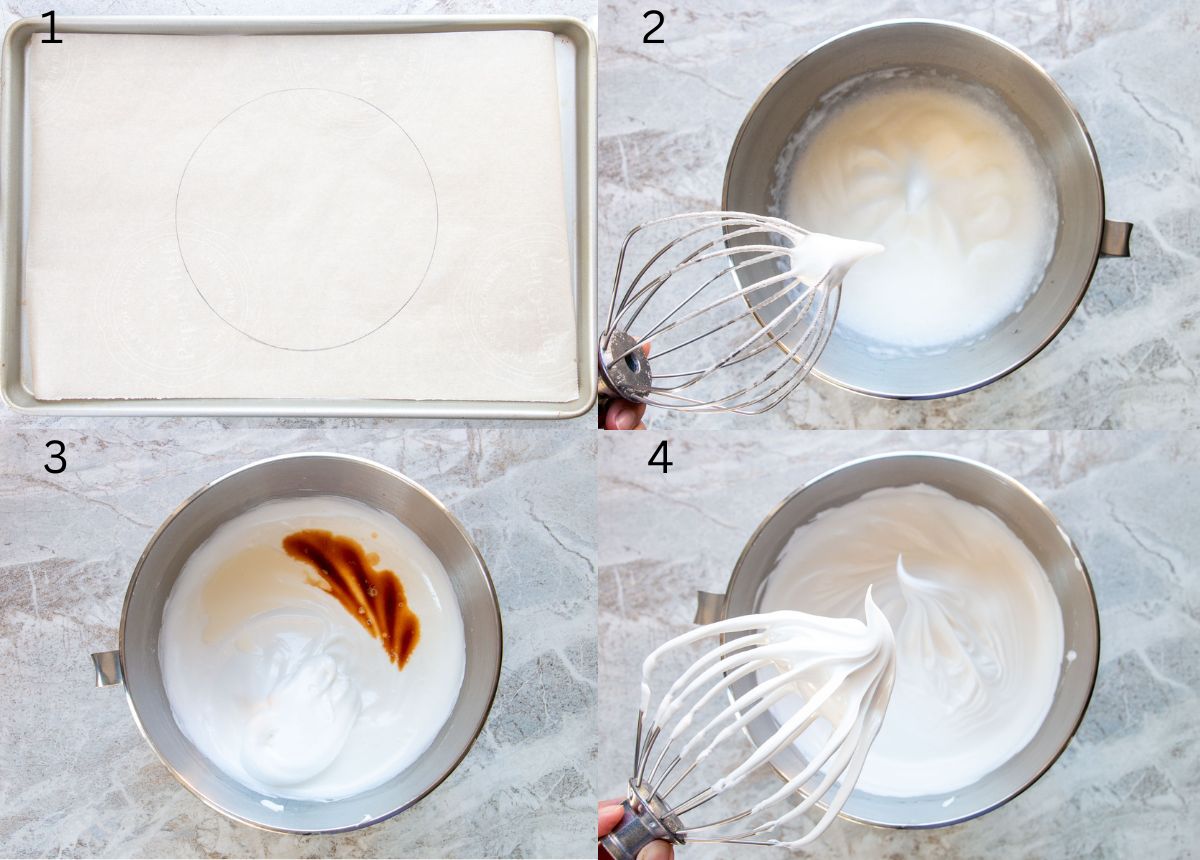
- Preheat oven to 300F. Trace an 8″ circle onto a sheet of parchment and set aside.
- In a large mixing bowl, beat the egg whites to soft peaks (a peak that curls over). Slowly mix in the sugar, one tablespoon at a time. The meringue will start to appear glossy at this point. Continue mixing until all the sugar has been added.
- In a pinch bowl, combine the cornstarch and vinegar, mix into a slurry and add to the meringue along with the vanilla.
- Continue beating until all the sugar has dissolved (the mixture should feel smooth when rubbed between your fingers) and stiff peaks form (when the beater is lifted, the mixture holds a strong peak that does not move).
- Dab a small amount of meringue onto all four corners of your baking sheet (this helps keep the parchment paper in place) and place the prepared parchment paper on top (pencil or pen side down). Pile the meringue into the middle of the circle.
- Using an offset spatula or large spoon, spread out the meringue into an 8″ circle as drawn. Create a furrow along the edges using the same offset spatula or spoon, smooth out the top surface edges, and then create a divot in the center. Place in the oven, reduce the temperature to 200F, and bake for 90 minutes. Turn off the oven and let the pavlova slowly cool inside the oven for 4 hours or overnight.
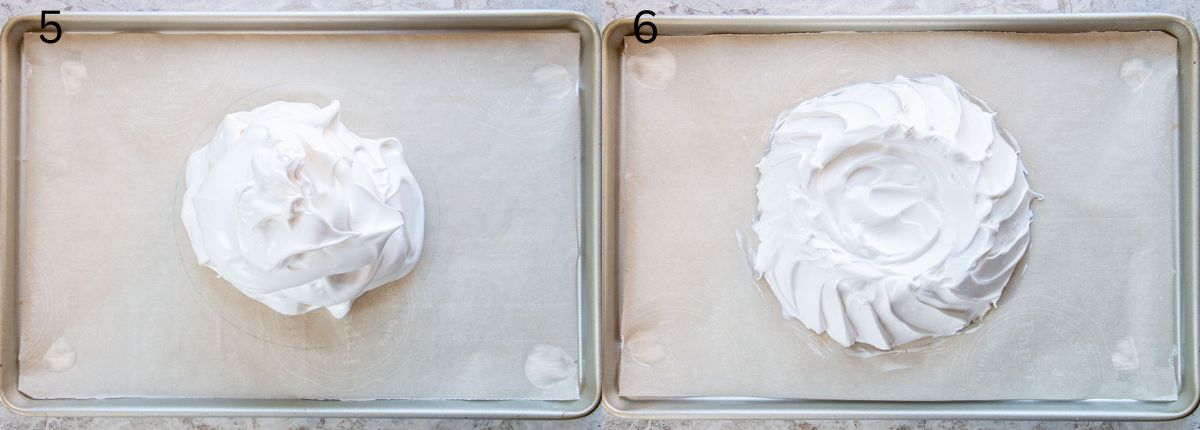
Expert tips:
- Avoid making pavlovas on humid and rainy days – The pavlova will absorb the extra moisture in the air, causing it to possibly shrink too much in the oven or become sticky upon cooling.
- Make sure all equipment is clean and dry – I like to wipe my mixing bowl, the beater, and all my utensils with a paper towel dampened with vinegar before I start, to make sure it’s all clean and there is no grease on any surface area.
- Use superfine or caster sugar – The smaller granules dissolve faster than regular granulated sugar. You can get away with using granulated sugar – it will just take longer to dissolve.
- Use fresh store-bought eggs – The protein structure in fresh egg whites is stronger and will produce a more stable meringue.
- Separating the eggs – Be careful when separating the eggs and do not let any egg yolk get mixed in with the egg whites. Egg yolks contain fat, which can interfere with the whipping process and prevent the egg whites from achieving stiff peaks. It’s best to separate the egg whites over a small bowl and adding them into your mixing bowl one at a time.
- Make sure all the sugar has dissolved – Take a little meringue to your fingertip and rub it between your thumb and index finger. If it feels gritty, then it needs more time being whisked. Keep checking periodically until the meringue feels smooth.
- Do not open the oven door during baking – The sudden temperature change might cause the pavlova to collapse. Just turn on the light and look through the glass to check on how your pavlova is progressing.
The big question: What to do with the leftover egg yolks?
From custards to sauces to golden fried rice, there are many uses for leftover egg yolks. Here are three of my own recipes you can make:
How to serve:
Pavlovas are commonly served topped with whipped cream and fresh fruit. Variations can include a variety of fruits, flavored creams, along with fruit curds like lemon or passion fruit, and additional toppings like chopped nuts and chocolate shavings.
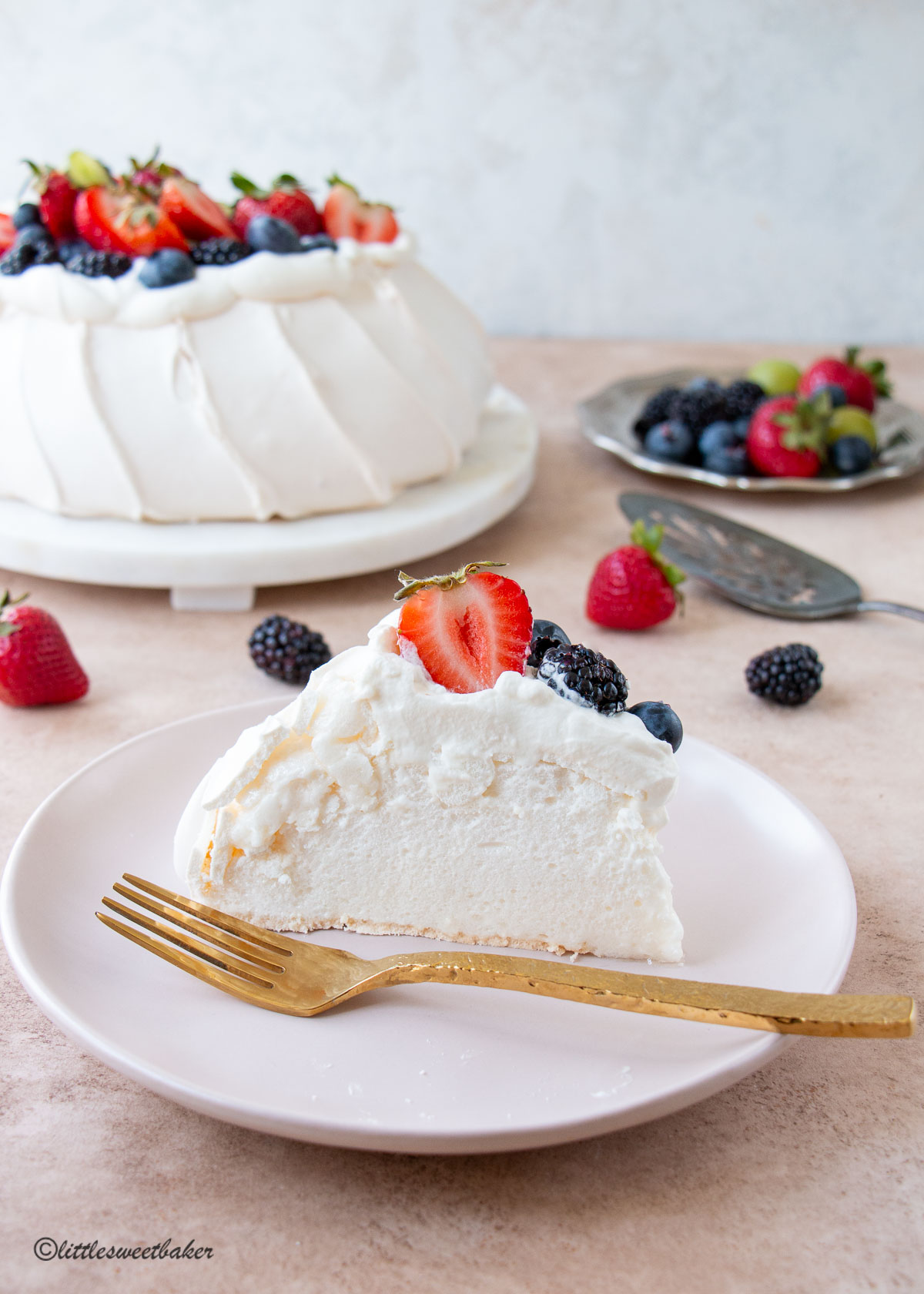
FAQ:
While both are made from whipped egg whites and sugar, pavlova is a specific type of meringue dessert with additional ingredients and a distinct texture. Pavlova has a delicate, crispy exterior with a pillowy, soft marshmallow inside, while meringue is typically dry and crisp all the way through.
Yes, because it takes a long time to slowly and completely cool down in the oven.
Pavlova can crack due to many reasons. The most common ones are overbeating egg whites, sudden temperature changes, excess moisture, improper baking, and rapid cooling. Overwhipping can destabilize the meringue, while temperature fluctuations and moisture can affect its structure. Incorrect baking conditions, like high temperatures or uneven cooking, can also contribute. Gradual cooling is essential to prevent abrupt contraction and cracking.
Don’t worry! Simply cover it up with the whipped cream and fruits and serve it because it’s going to crack when you cut into it anyway, and it will still be delicious.
You can store a pavlova base (without toppings) in an airtight container at room temperature for up to 2 days. Be sure to keep it in a cool, dry place, away from direct sunlight and moisture.
Unfortunately, no. The moisture upon freezing and thawing will ruin the crispy outer texture.
You might also like:
Did you make this recipe? Please kindly leave a comment with your star rating below.
Print
Easy Pavlova Recipe
- Prep Time: 20 min
- Cook Time: 90 min
- Total Time: 1 hour 50 minutes
- Yield: 10 servings
- Category: dessert
- Method: bake
- Cuisine: Australian or New Zealand
Description
Crisp on the outside, marshmallowy on the inside, and topped with billowy whipped cream and a vibrant fruit medley, this pavlova is sure to steal the show at any gathering.
Ingredients
Pavlova
- 6 large egg whites, at room temperature
- 1 & 1/2 cups (300g) granulated sugar
- 1 tsp white vinegar
- 2 tsp cornstarch
- 1 tsp vanilla extract
Toppings
- 1 cup heavy whipping cream
- 3 tbsp powdered sugar
- 1/2 tsp vanilla extract
- 2–3 cups mixed fruit (I used strawberries, blueberries, blackberries, and green grapes)
Instructions
- Preheat oven to 300F. Trace an 8″ circle onto a sheet of parchment and set aside.
- In a large mixing bowl, beat the egg whites to soft peaks (a peak that curls over). Slowly mix in the sugar, one tablespoon at a time. The meringue will start to appear glossy at this point. Continue mixing until all the sugar has been added.
- In a pinch bowl, combine the cornstarch and vinegar, mix into a slurry and add to the meringue along with the vanilla.
- Continue beating until all the sugar has dissolved (the mixture should feel smooth when rubbed between your fingers) and stiff peaks form (when the beater is lifted, the mixture holds a strong peak that does not move).
- Dab a small amount of meringue onto all four corners of your baking sheet (this helps keep the parchment paper in place) and place the prepared parchment paper on top (pencil or pen side down). Pile the meringue into the middle of the circle.
- Using an offset spatula or large spoon, spread out the meringue into an 8″ circle as drawn. Create a furrow along the edges using the same offset spatula or spoon, smooth out the top surface edges, and then create a divot in the center.
- Place in the oven, close the door, reduce the temperature to 200F, and bake for 90 minutes. Turn off the oven and let the pavlova slowly cool inside the oven for 4 hours or overnight with the door closed.
- Just before serving, beat the heavy cream, powdered sugar, vanilla extract together until medium or stiff peaks form. Spoon the whipped cream on top of the pavlova and decorate with the fruit. Slice using a sharp serrated knife.
Recipe adapted from The Flavor Bender


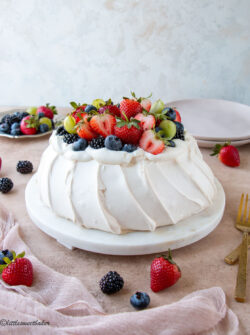


I served this pavlova at a recent dinner party. It turned out perfectly – very light and tasty.
I’m so happy to hear and thank you for your feedback!
What a gorgeous pavlova!! We lived in Australia for a few years and this dessert brings me back to those wonderful times. Thanks for inspiring me to make it at home!
Look at this fluff! It’s the perfect cake for Mother’s Day! Funny, it’s got this Russian name, although it’s from Australia/N-Zeland. I might try it soon, although Meringue always scares me technically. It looks lovely!
This is the queen of all pavlovas and I think any Aussie or Kiwi would be suitably impressed! I love how it’s shaped so beautifully and piled high with fruit. A showstopper at any occasion.
Thank you, Bernice, and I hope you give it a try:)